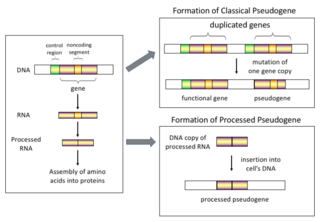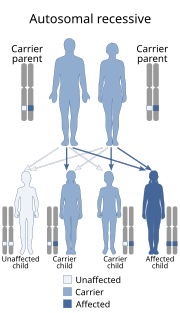
Pseudogenes, sometimes referred to as zombie genes in the media, are segments of DNA that are related to real genes. Pseudogenes have lost at least some functionality, relative to the complete gene, in cellular gene expression or protein-coding ability. Pseudogenes often result from the accumulation of multiple mutations within a gene whose product is not required for the survival of the organism, but can also be caused by genomic copy number variation (CNV) where segments of 1+ kb are duplicated or deleted. Although not fully functional, pseudogenes may be functional, similar to other kinds of noncoding DNA, which can perform regulatory functions. The "pseudo" in "pseudogene" implies a variation in sequence relative to the parent coding gene, but does not necessarily indicate pseudo-function. Despite being non-coding, many pseudogenes have important roles in normal physiology and abnormal pathology.
Tumor hypoxia is the situation where tumor cells have been deprived of oxygen. As a tumor grows, it rapidly outgrows its blood supply, leaving portions of the tumor with regions where the oxygen concentration is significantly lower than in healthy tissues. Hypoxic microenvironements in solid tumors are a result of available oxygen being consumed within 70 to 150 μm of tumour vasculature by rapidly proliferating tumor cells thus limiting the amount of oxygen available to diffuse further into the tumor tissue. In order to support continuous growth and proliferation in challenging hypoxic environments, cancer cells are found to alter their metabolism. Furthermore, hypoxia is known to change cell behavior and is associated with extracellular matrix remodeling and increased migratory and metastatic behavior.

Phosphofructokinase-2 (6-phosphofructo-2-kinase, PFK-2) or fructose bisphosphatase-2 (FBPase-2), is an enzyme indirectly responsible for regulating the rates of glycolysis and gluconeogenesis in cells. It catalyzes formation and degradation of a significant allosteric regulator, fructose-2,6-bisphosphate (Fru-2,6-P2) from substrate fructose-6-phosphate. Fru-2,6-P2 contributes to the rate-determining step of glycolysis as it activates enzyme phosphofructokinase 1 in the glycolysis pathway, and inhibits fructose-1,6-bisphosphatase 1 in gluconeogenesis. Since Fru-2,6-P2 differentially regulates glycolysis and gluconeogenesis, it can act as a key signal to switch between the opposing pathways. Because PFK-2 produces Fru-2,6-P2 in response to hormonal signaling, metabolism can be more sensitively and efficiently controlled to align with the organism's glycolytic needs.

1,3-Bisphosphoglyceric acid (1,3-Bisphosphoglycerate or 1,3BPG) is a 3-carbon organic molecule present in most, if not all, living organisms. It primarily exists as a metabolic intermediate in both glycolysis during respiration and the Calvin cycle during photosynthesis. 1,3BPG is a transitional stage between glycerate 3-phosphate and glyceraldehyde 3-phosphate during the fixation/reduction of CO2. 1,3BPG is also a precursor to 2,3-bisphosphoglycerate which in turn is a reaction intermediate in the glycolytic pathway.

Phosphoglycerate kinase is an enzyme that catalyzes the reversible transfer of a phosphate group from 1,3-bisphosphoglycerate (1,3-BPG) to ADP producing 3-phosphoglycerate (3-PG) and ATP :

Phosphoglycerate mutase (PGM) is any enzyme that catalyzes step 8 of glycolysis. They catalyze the internal transfer of a phosphate group from C-3 to C-2 which results in the conversion of 3-phosphoglycerate (3PG) to 2-phosphoglycerate (2PG) through a 2,3-bisphosphoglycerate intermediate. These enzymes are categorized into the two distinct classes of either cofactor-dependent (dPGM) or cofactor-independent (iPGM). The dPGM enzyme is composed of approximately 250 amino acids and is found in all vertebrates as well as in some invertebrates, fungi, and bacteria. The iPGM class is found in all plants and algae as well as in some invertebrate, fungi, and Gram-positive bacteria. This class of PGM enzyme shares the same superfamily as alkaline phosphatase.

Retinal guanylyl cyclase 1 also known as guanylate cyclase 2D, retinal is an enzyme that in humans is encoded by the GUCY2D gene.

Phosphoglycerate kinase 1 is an enzyme that in humans is encoded by the PGK1 gene.

Cyclic AMP-dependent transcription factor ATF-1 is a protein that in humans is encoded by the ATF1 gene.

Phosphorylase b kinase gamma catalytic chain, skeletal muscle isoform is an enzyme that in humans is encoded by the PHKG1 gene.

Tyrosine-protein kinase receptor TYRO3 is an enzyme that in humans is encoded by the TYRO3 gene.

60S ribosomal protein L41 is a protein that in humans is encoded by the RPL41 gene.

Adenylate kinase isoenzyme 4, mitochondrial is an enzyme that in humans is encoded by the AK3L1 gene.

Myosin light chain kinase, smooth muscle also known as kinase-related protein (KRP) or telokin is an enzyme that in humans is encoded by the MYLK gene.
Serine/threonine-protein kinase PRKY is an enzyme that in humans is encoded by the PRKY gene.

D-Glyceric Acidemia is an inherited disease, in the category of inborn errors of metabolism. It is caused by a mutation in the gene GLYCTK, which encodes for the enzyme glycerate kinase.
Glycerate 2-kinase is an enzyme with systematic name ATP:D-glycerate 2-phosphotransferase. This enzyme catalyses the following chemical reaction

Protein kinase, X-linked is a protein that in humans is encoded by the PRKX gene.

Dual specificity phosphatase 8 is a protein that in humans is encoded by the DUSP8 gene.
Eukaryotic translation elongation factor 1 beta 2 pseudogene 3 (eEF1B4) is a protein that in humans is encoded by the EEF1B2P3 gene.

















